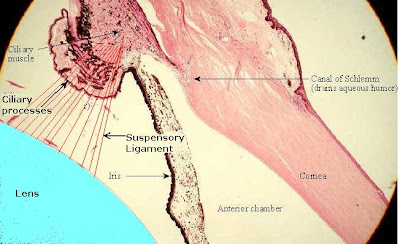
Friday, March 27, 2009
Astigmatism

Thursday, March 26, 2009
Ciliary Disk
Wednesday, March 25, 2009
Optic Nerve
The optic nerve consists of retinal ganglion cell axons and Portort cells, leaving the orbital bone via the optic canal. It runs postero-medially towards the optic chiasm where there is a partial crossing of fibers from the nasal visual fields of both eyes. The majority of the axons of the optic nerve end in the lateral geniculate nucleus from which information is relayed to the visual cortex of the occipital lobes of the brain.

Tuesday, March 24, 2009
Phototransduction

Monday, March 23, 2009
Photoreceptor

Friday, March 20, 2009
Retina


Thursday, March 19, 2009
Ciliary Processes
The ciliary processes are arranged in a circle, and form a type of frill behind the iris, around the margin of the lens. Together they form 60-80 radial ridges located behind the iris and around the margin of the lens.

Ciliary Body

Wednesday, March 18, 2009
Zonule of Zinn


Tuesday, March 17, 2009
Ciliary Muscle


Monday, March 16, 2009
Human Eye

Saturday, March 14, 2009
Proton

Friday, March 13, 2009
Pion

Mesons

Thursday, March 12, 2009
Baryons

Wednesday, March 11, 2009
Hadrons
Hadrons consist of quarks, either as quark-antiquark pairs (mesons) or as three quarks (baryons). Quarks are surrounded by a cloud of gluons, the exchange particles for the color force. Recent experimental evidence has showed the existence of five-quark combinations that are being called pentaquarks.
Hadrons are assigned quantum numbers which correspond to the representations of the Poincaré group: JPC(m), where J is the spin quantum number, P, the intrinsic (or P) parity, and C, the charge conjugation, or C parity, and the particle four-momentum, m.
Tuesday, March 10, 2009
Quarks
As they are confined by the strong force fields, quarks only exist inside hadrons. As a result, it is impossible measure their mass by isolating them. There are six types of quarks which are known as flavors: up (u), down (d), charm (c), strange (s), top (t) and bottom (b). The up and down quarks have the lowest masses of all quarks, and thus are generally stable and very common in the universe. The other quarks are much more massive, and will rapidly decay into the lighter up and down quarks. The heavier charm, strange, top and bottom quarks can only be produced in high energy collisions, such as in particle accelerators and cosmic rays.

Tau Lepton
Monday, March 9, 2009
Giant Magnetoresistance

Friday, March 6, 2009
Positron
Quantum Mechanics
Quantum mechanics is a set of principles which underlies fundamental known description of all physical systems at the microscopic scale at the atomic level. It is the study of matter and radiation at an atomic level. Among these principles are both a dual wave-like and particle-like behavior of matter and radiation, and prediction of probabilities in situations where classical physics predicts certainties. Classical physics can be derived as a good approximation to quantum physics, typically in circumstances with large numbers of particles. Thus quantum phenomena are relevant in systems whose dimensions are close to the atomic scale, such as molecules, atoms, electrons, protons and other subatomic particles.
The word quantum refers to a discrete unit that quantum theory assigns to certain physical quantities, such as the energy of an atom at rest. Quantum mechanics is vital in order to comprehend the behavior of systems at atomic length scales. If classical mechanics governed the workings of an atom, electrons would rapidly travel towards and collide with the nucleus, making stable atoms impossible. Nevertheless, in the natural world the electrons usually remain in an unknown orbital path around the nucleus, defying classical electromagnetism.
Thursday, March 5, 2009
Spontaneous Broken Symmetry
To help explain spontaneous broke symmetry a common example is usually given; a ball sitting on top of a hill in a completely symmetric state. However, its state is unstable: the slightest disturbance will cause the ball to roll down the hill in some particular direction into its lowest energy state. At that point, symmetry has been broken. A symmetrical situation therefore collapses into an asymmetrical state.
Spontaneous broken symmetry conceals nature’s order under a seemingly jumbled surface. In 1960, Yoichiro Nambu formulated the mathematical description of spontaneous broken symmetry in elementary particle physics. The spontaneous broken symmetries which Nambu formulated, differ from the broken symmetries described by Toshihide Maskawa and Makoto Kobayashi. These spontaneous occurrences seem to have existed in nature since the very beginning of the universe and came as a complete surprise when they first appeared in particle experiments in 1964.
Wednesday, March 4, 2009
Antibiotic
Anti-bacterial antibiotics are categorized based on their target specificity: narrow-spectrum antibiotics target particular types of bacteria, such as Gram-negative or Gram-positive bacteria, while broad-spectrum antibiotics affect a wide range of bacteria.
There are several classes of antibiotics:
1) Aminoglycosides: gentamicine, amikacin, neomicyn, streptomycin, etc. Efective in the treatment against infections caused by Gram-negative bacteria, such as Escherichia coli and Klebsiella particularly Pseudomonas aeruginosa. Effective against Aerobic bacteria.
2) Cephalosporins: Cefadroxil, Cefazolin, etc.
3) Macrolides: azithromycin, clarithromicyn, erythromicyn, etc. They are used in the treatment of streptococcal infections, syphilis, respiratory infections, mycoplasmal infections, Lyme disease.
4) Penicillins: amoxicillin, ampicillin, penicillin, oxacillin, etc. Used against a wide range of infections; penicillin is used against streptococcal infections, syphilis, and Lyme disease.
Tuesday, March 3, 2009
Amikacin
Amikacin is used for treating infections of central nervous system, urogenital system, biliary and intestinal tracts, intraabdominal infections, and pneumonia, caused by Gram-negative microorganisms, secondary infections after combustion, bacterial septicemia, infections of the bones and joints.
Amikacin is administered once or twice a day by the intravenous or intramuscular route, which tends to be painful. There is no oral form available.
Monday, March 2, 2009
Streptomycin
